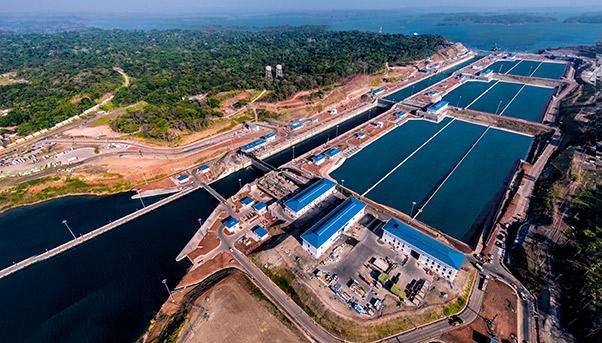Every story has a beginning. And the one for the new Panama Canal dates back to July 15, 2009 when the Panama Canal Authority signed a contract with Grupo Unidos por el Canal (GUPC), the consortium that won the public tender to build it.
Less than a month later, work on the third set of locks began, opening up an enormous construction site with numbers that were just as big: 74 million cubic metres of excavated earth, 290,000 tonnes of iron, 5 million cubic metres of concrete, more than 100 million working hours. An impressive and complex job that responded to the criteria of environmental sustainability.
The expansion was not to have a negative impact on the environment and water consumption while satisfying the demands of Panama to remain at the nerve centre of global maritime trade. The new Canal meets these fundamental demands.
Its size allows for the passage of Post-Panamax ships, which are 1,200 feet long, 160 feet wide with a draft of 50 feet. This means that the amount of cargo being transported has tripled: from 5,000 to 12,600 twenty-foot equivalent units (TEUs).
To complete the project, there came the idea of a system of 16 locks (eight on the Atlantic and eight on the Pacific) each weighing between 2,500 and 4,000 tonnes and up to 33 metres in height. The opening and closing of the sluice gates, accompanied by the filling and emptying of the water basins next to the Canal, would guarantee the raising and lowering of ships coming to and from the Gatun Lake, which is located above sea level.
To enter the lake, a ship is raised 27 metres before entering it. To leave the lake after crossing it, the ship is then lowered by the same amount at the other set of locks on the opposite coast. The movement of the sluice gates are a mechanical and technological wonder because each manoeuver, with the passage of a ship, has to be done with infinitesimal precision, each gate completing its function in just five minutes or less.

Genesis of a Public Work
Their movement anticipates that of the water which, taking advantage of the interconnected basins, passes from the enormous basins to one of the canal’s three chambers. The water consequently lifts the ship inside the chamber in three phases before letting it sail into the lake. The process is repeated but in reverse on the other side of the isthmus. The system of water basins reduces as much as possible the amount of water lost thanks to a second canal running parallel to the new one. It gathers the water that leaves the canal and returns it to the basins. In this way, 60% of the water is saved, using 200 million litres rather than the 500 million if the new Canal would have followed the model of the old one.
«The entire mechanism runs on gravity without even a pump», says Giuseppe Quarta of Salini Impregilo and chief executive of GUPC. «Water comes out of the basin, fills the canal, lifts the ship. When the ship passes to the next level, the water leaves the canal’s chamber and returns to fill up the basis according to the same principles. The incredible thing about the new Canal is that it uses less water than the other one. Some 60% of the water used is recycled. Notwithstanding its enormous size, this is a project with very low environmental impact».
All photos of “The New Panama Canal” Special Issue are copyrighted: Copyright © Edoardo Montaina by Salini-Impregilo

